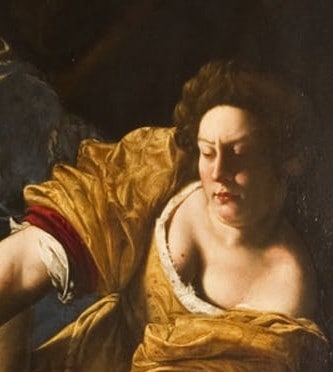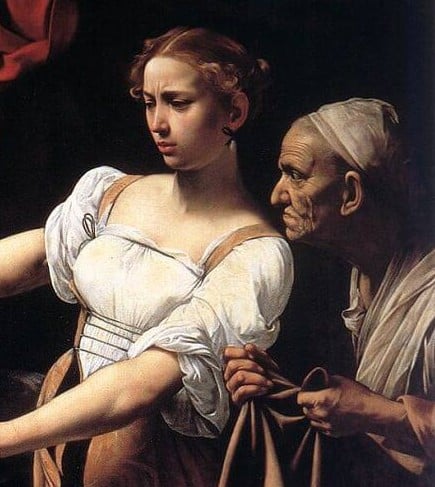Call free on: 0800 389 2839
Call free on: 0800 389 2839
Join in... The latest news and blogs from NEC
Women in art history and the resurgence of Artemisia Friday, 31 July 2020

This blog post was written by NEC A level History of Art student Fleur. Due to themes and images that may be disturbing to some readers we have cropped the images – the full paintings can be viewed by clicking on the images.
“You will find the spirit of Caesar in this soul of a woman”
Artemisia Gentileschi

Artemisia Gentileschi, Judith and Holofernes, 1620-21, oil on canvas, 162.5 x 199 cm
One of the many reasons why I wanted to study art history was to widen my knowledge of female artists. One particular female artist keeps cropping up time and time again wherever I go lately.
I was first introduced to Artemisia Gentileschi by a friend who sent me a link to watch ‘It’s True, It’s True, It’s True’ by the theatre company Breach that was streaming on the Barbican website during the early days of lockdown. The show was the dramatisation of the painter Artemisia Gentileschi’s rape trial in 1612 which took place when she was only 15 and her harrowing court experiences.
Another friend recently wrote a script based around one of her paintings for her course, I then found her in the set text book and now I have just discovered there is to be a show featuring many of her paintings coming to the National Gallery in October.

Caravaggio, Judith Beheading Holofernes, 1599, Oil on canvas, 145 x 195 cm
I simply cannot believe that I have never heard of her until this year, why have I heard of Caravaggio and not Gentileschi? She is an Italian Baroque painter famous (but not famous enough) for painting Biblical scenes such as the above depiction of Judith beheading Holofernes. Caravaggio also painted this scene, before Gentileschi…
In which painting does the woman really get stuck in with relish? If someone was to tell you that one painting was painted by a man and one by a woman I think you could tell who painted which painting, this is even without having any of the context of what happened to Gentileschi.
Caravaggio’s Judith looks like she really doesn’t want to be there and I cannot imagine her having the strength to chop his head off, she is delicately leaning away from Holofernes and her youth and beauty stand in sharp contrast to the older woman beside her.
Gentileschi’s Judith on the other hand looks strong and determined and the force of her actions have splattered blood on her chest and arms (in contrast to Carravaggio’s Judith with her spotless arms and clothes). Judith is clearly finely adorned with her gold bracelet and lavish rich looking clothes and it is a shock to see such a finely dressed woman actually physically doing something, literally anything, in art during the Baroque era, let alone committing murder with such grim determination.
Although Gentileschi was well known while she was alive she largely disappeared until the 1990s. I don’t think she will disappear again any time soon and I can’t wait to see her work in real life in October.
My recommendations to explore women in art:
- Women’s Art blog: Celebrating women’s art and creativity
- The Great Women Artists: In the most recent episode, Katy Hessel interviews one of the most groundbreaking, important, and influential artists working in the world today, the Turner-Prize winning artist, Lubaina Himid
- The Artemisia exhibition at the National Gallery
Read Fleur’s previous blog post here.
Fleur is studying A level History of Art with NEC. To learn more about this innovative and interactive course, visit the course page.
Leave a Reply Cancel reply
More stories
working at NEC
Uncategorized
- Balancing an A level with My Passion for Dance
- The Future of Art History: Why Study A level History of Art with the National Extension College?
- Why Study Physics?
- Embracing a New Path: Jill’s Journey from Online Learning to Career Success in Art History
- How Toby Found a Perfect Fit for His Passion: Online A level English Literature with NEC
Study Tips
Student Stories
- Balancing an A level with My Passion for Dance
- Passion and Academics: How Izzy Balances Full-time Musical Theatre Studies with Studying A level Physics
- How NEC Helped Kari’s Son Niko to Continue his A level Studies Despite Long-Term Illness
- Embracing a New Path: Jill’s Journey from Online Learning to Career Success in Art History
- How Toby Found a Perfect Fit for His Passion: Online A level English Literature with NEC
SFT
Results Day
- Resitting A level STEM Subjects: How to Turn Your Setback into a Stepping Stone for a Brighter Future
- Resits vs. Retakes: Understanding the Difference and Making the Most of Your Second Chance
- GCSE Results Day 2024: What to Do When You Didn’t Get the GCSE Results You Wanted
- GCSE Results Day 2024: Your Complete Guide
- A level Results Day 2024: Your Ultimate Guide to Success
Policy and Campaigns
- A Pathway to Success Beyond A levels: Why Level 4 and Level 5 Qualifications Matter
- Schools and Academies Show 2024: Insights for School Leaders
- Big Data and Educational Trends: Insights for Students and Schools
- University of Cambridge Institute of Continuing Education offers tuition fee bursary for NEC A level students
- Five study bursaries for state sector teachers to take online A level Classical Civilisation offered by The Classical Association
Podcast
Our Courses
- Balancing an A level with My Passion for Dance
- How NEC’s Inclusive Approach to Learning Design is Redefining Independent Learning
- NEC’s Learning Design: A Pathway to Success for Independent Learners
- Passion and Academics: How Izzy Balances Full-time Musical Theatre Studies with Studying A level Physics
- Why Study Psychology? – Key Benefits, Careers and What You’ll Need to Study Psychology at University
Lifelong Learning
- A Pathway to Success Beyond A levels: Why Level 4 and Level 5 Qualifications Matter
- Benefits of Homeschooling: Is Home Education Right for Your Family?
- How NEC’s Inclusive Approach to Learning Design is Redefining Independent Learning
- The Future of Art History: Why Study A level History of Art with the National Extension College?
- National Coding Week 2024: The Vital Role of Coding in the Modern World
Home Schooling
- Benefits of Homeschooling: Is Home Education Right for Your Family?
- How NEC Helped Kari’s Son Niko to Continue his A level Studies Despite Long-Term Illness
- Exploring Science Practicals at Home: A Guide for Homeschoolers
- Homeschooling in 2024: How to Personalise Your Child’s Education
- What is Homeschooling?
Guest Blogs
- Passion and Academics: How Izzy Balances Full-time Musical Theatre Studies with Studying A level Physics
- My Experience as a Marketing Intern with the National Extension College
- The economics of political parties
- Embarking on a journey: My decision to ‘Fast-Track’ A level Physics with NEC
- Homeschooler Andrew’s experience of studying IGCSE Chemistry
General
- Balancing an A level with My Passion for Dance
- A Pathway to Success Beyond A levels: Why Level 4 and Level 5 Qualifications Matter
- Schools and Academies Show 2024: Insights for School Leaders
- How NEC’s Inclusive Approach to Learning Design is Redefining Independent Learning
- NEC’s Learning Design: A Pathway to Success for Independent Learners

Add a new comment
Current comments: 0